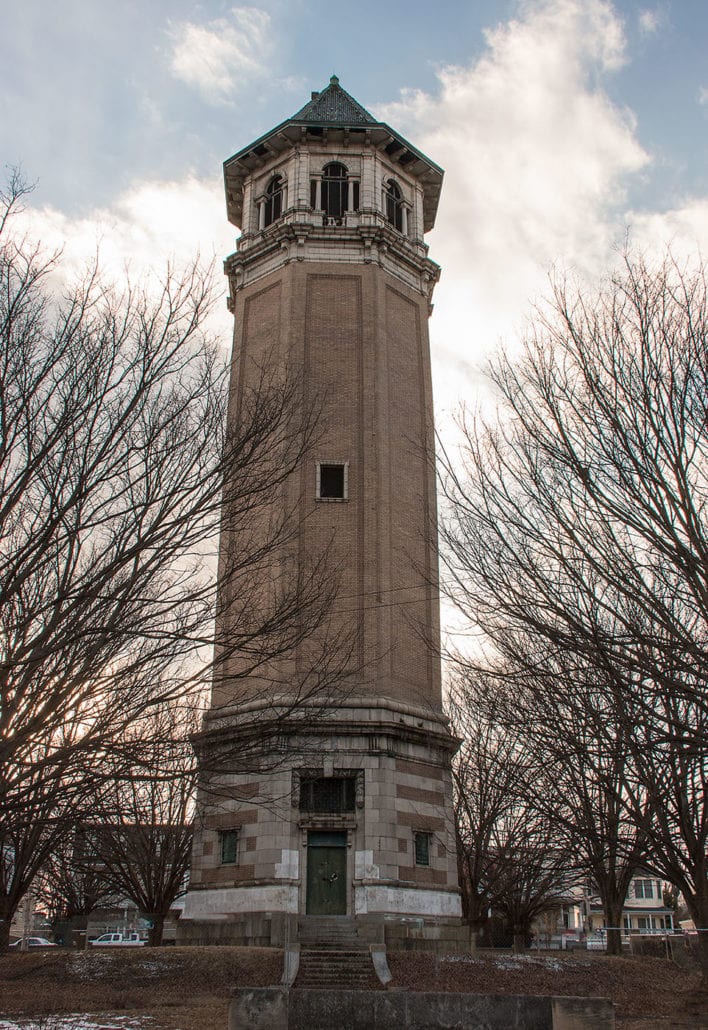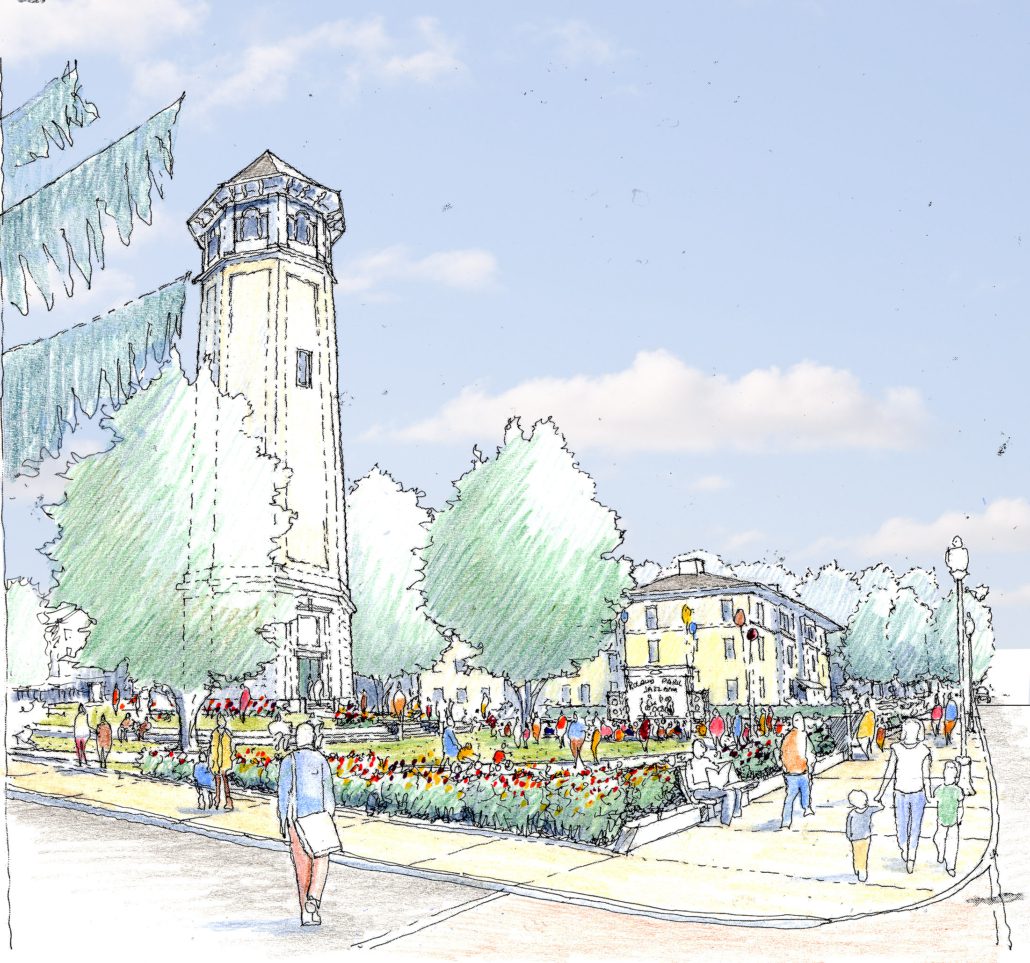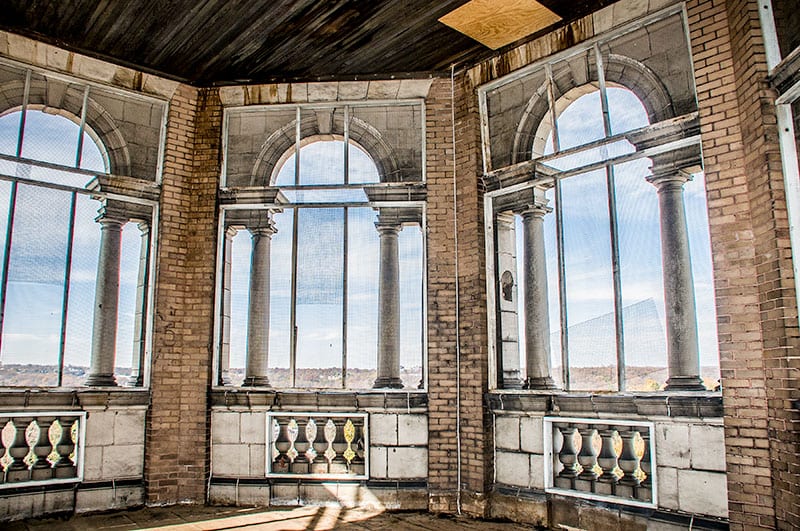Roland Water Tower Update, Spring 2019
By Mary Page Michel
After years of planning, the work on the Roland Water Tower will begin in 2019. There have been more twists and turns, starts and restarts in the restoration of this iconic structure than there have been in a blockbuster mystery novel. Finally, the ink has dried and there is a legal agreement between the Roland Park Community Foundation (RPCF) and Baltimore City and the project will commence this year.
The City will begin the project’s design this spring. This work can take anywhere from six months to a year. When complete, the City will hand over the design to the RPCF and construction will begin, most likely in early 2020.
The octagonal, 148-foot Roland Water Tower sits between four neighborhoods: Roland Park, Hoes Heights, Rolden and Hampden. It is located at the intersection of University Parkway, Roland Avenue and Evans Chapel Road. Originally built in 1905 to provide water for Hampden, the Beaux Arts tower stored 211,000 gallons of water. It was decommissioned in the 1930s when the City’s reservoir system was installed. The area around the tower became a transportation hub—used as a turnaround spot for streetcars and then buses—but it eventually fell out of use. Over the years, the tower fell into disrepair and, in 2009, the City erected a chain link fence to protect people from falling debris.
We chose the restoration of the Roland Water Tower as one of three major projects recommended in the 2011 Greater Roland Park Master Plan (rolandpark.org/community-resources/master-plan). With a mission to improve green and public spaces in our community, the RPCF understood this historic gem was not on the list of top priorities for the City and the only way for it to be preserved was if the community stepped up.
In the summer of 2009, a new preservation group was formed—the Friends of the Roland Water Tower (facebook.com/groups/rolandh2otower). It is comprised of residents, most living in close proximity to the tower, who care deeply about the restoration. They occasionally hold community events to fundraise for the project. Group Chair Suzanne Frasier, who has been a leader on the Roland Water Tower team, brings her experience as an architect and designer, which has been and will continue to be crucial to the success of the project.
Restoration will begin at the top of the heavily damaged tower. The terra cotta roof, roof soffits and balustrades are in disrepair. This work will allow the fence to be removed, which will mark a significant milestone. After the tower’s exterior is restored, the 0.75-acre land on which it sits will be improved as a pocket park for the community. If funding allows, there will be lighting to showcase the historical gem that is the Roland Water Tower.
How do we pay for all of this? The State awarded a Bond Bill of $250,000 to the City for the tower in 2012 on the condition that the community matched that amount in donations. Thanks to the generosity of Open Space Campaign donors, we raised the matching funds. The City committed a portion of the funds allocated to demolish the tower, up to $337,000. A delegation in Annapolis is currently reviewing another smaller Bond Bill and the City has committed more limited funds. It is likely that additional funding will be needed, but that will be determined after the design is complete, when construction estimates will be available. Delegate Sandy Rosenberg has been a champion for this project in Annapolis.
Why has it taken so long? There have been three large stumbling blocks along the way. The first was determining which City department would be responsible for the Roland Water Tower, which was originally part of the city’s water supply and fell under the Department of Public Works (DPW). DPW had no capacity to or interest in restoring the tower. The Department of General Services oversees monuments, so it made sense that it would be responsible for the tower and, in 2013, the Board of Estimates (BOE) approved that change. Al Copp, a Roland Park resident who passed away in 2017, was instrumental in getting this change made as well as pushing this project forward for the first six years. Deputy Mayor Pete Hammen in Mayor Catherine Pugh’s administration oversees the team at City Hall, and City Councilpersons Mary Pat Clarke and Sharon Green Middleton have advocated for this project for many years.
The second stumbling block was dividing the work of restoring the Roland Water Tower. The City suggested that the RPCF turn over the private funds raised as part of the Open Space Campaign so that it could handle the project. We did not feel comfortable doing this, so it was agreed that the work would be split between the City and the RPCF. For many years, the City suggested that we do the design work and the City would do the construction. The RPCF, under the leadership of Copp, worked with multiple design firms but ultimately none of them would commit to doing the design with the City doing the construction. Firms did agree to do the design work for the City with the RPCF doing the construction. So the roles reversed.
The latest challenge was creating an agreement between the City and the RPCF. It took more than a year to hammer out the details of this complicated relationship. The final document was agreed upon in January 2019. Don McPherson, a resident of Roland Park, led the negotiations for the community. McPherson is the attorney who assisted the Mt. Vernon Place Conservancy with the legal negotiations with the City over the Washington Monument. He has generously donated both time and expertise, which have been critical to moving this project forward.
What is the timeline? The agreement between the City and the RPCF must be approved by the BOE, a process the City estimates will take six weeks. Next, the BOE has to approve the contract between the City and its design firm, JMT. It is estimated this will take two months.
After contract approval, JMT will begin the design work. They are required, by contract, to complete the project in under a year, but we hope it will only take approximately six months. We hired an owner’s representative, Tom McCracken, to negotiate with JMT on the design. McCracken also worked for the Mt. Vernon Place Conservancy during negotiations with the City regarding the Washington Monument. The desired outcome is a design that the community wants and can afford.
Once the design is complete, JMT will provide a cost estimate for the project. We then have 120 days to hire a construction company.
Could the Roland Water Tower fall down? It is doubtful. In 2011, the RPCF won a matching $2,500 grant from the Heritage Fund—a joint program sponsored by Preservation Maryland and the Maryland Historical Trust—to have an engineering study done of the Tower. The study found that the structure was sound.
Could the City demolish it? In 1974, the Roland Water Tower was listed on the National Register of Historic Places and, in 2008, the City designated it a City Landmark Building. In 2011, it was designated by Preservation Maryland as one of 11 of the state’s most endangered sites. It cannot be demolished.
In a community that cares so deeply about history and historic structures, the restoration of the Roland Water Tower is a grand opportunity to restore our iconic neighborhood symbol and create a unique gathering space.
Mary Page Michel is chair of the board of the RPCF, a non-profit 501c(3) organization established in 1986 to preserve, maintain and improve the parks, streams, squares, trees and other green spaces in our community. Its mission is to benefit present and future generations of residents and stay true to the Olmsted Brother’s vision for this community.








